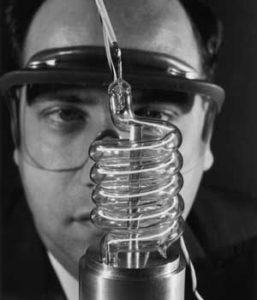
Laser and laser technologies have become a phenomenon of the 21st century, but its roots date back to the early 20th century.
- 1900 The German physicist, Max Planck, developed the basic idea of laser by assuming that light is made up of small pieces of energy – quantum.
- 1917 Albert Einstein understood the importance of Max Planck’s theory and discovered the law of the photoelectric effect – the so-called stimulated emission of radiation (deliberately induced emission of light quantum from atoms). In 1921 he received the Nobel Prize for this discovery.
- 1926 The American chemist, Gilbert Newton Lewis, termed a quantum of energy as photons.
- 1950s Several scientists applied for laser authorship. Charles Hard Townes and Arthur Leonard Schawlow obtained an American patent first. At the same time, Soviet scientists Nikolai Genadiyevich Basov and Alexander Mikhailovich Prokhorov came up with the same concept. In 1964, everyone (except Schawlow) was awarded the Nobel Prize in Physics for the invention of a laser. However, the dispute over the invention of the laser dragged on for 28 years and finally, the patent was shared by all four scientists.
- 16th of May 1960 The first functional (ruby) laser was uniquely designed and launched by American physicist and engineer, Theodore H. Maiman. At the same time, another American scientist, Gordon Gould, was working to launch the laser, but Maiman was faster.
- 1961 A year and half after the first laser commissioning, a unique eye surgery was performed at the Manhattan Columbia-Presbyterian Hospital. A retinal tumor was removed from the eye using a laser beam.
The magic year of 1963 in Czechoslovakia
- Czechoslovakia became the third country (after the USA and Soviet Union), who built it‘s own functional laser.
- The first Czechoslovakian laser was launched by Karel Pátek on the 9th of April 1963 at the Institute of Physics of the Czechoslovakian Academy of Sciences. Neodymium glass was used as it‘s active environment.
- Jan Blabla and Alena Jelínková from the Institute of Radioelectronics of the Czechoslovakian Academy of Sciences built a ruby laser, which was presented to the public at the Prague Planetarium.
- The Ruby Laser was also launched by J. Pachman at the Research Institute of the Ministry of National Defense in Prague.
- Tomislav Šimeček at the Institute of Solid State Physics of the Czechoslovakian Academy of Sciences, launched the first semiconductive laser.
- František Petrů and his team put the first gas laser into operation at the Institute of Scientific Instruments of the Czechoslovakian Academy of Sciences in Brno.
- 1960s – 1970s Since the mid-1960s, the intervention of the Soviet Union led to a decline in the development of lasers in Czechoslovakia.
- 1980s A new history of Czechoslovakian lasers, namely iodine lasers, began in the 1980s. The Institute of Physics of the Czechoslovakian Academy of Sciences received an iodine laser system as a gift, which was developed at the Lebedev Institute in Moscow. The laser was rebuilt, it’s concept was changed and thereafter put into operation in 1985 under the name PERUN. It‘s more powerful version, the PERUN II laser system, was launched in 1992.
- The Czech Republic’s Academy of Sciences became the operator of the Asterix laser, following a Euratom-assented agreement with the Max Planck Institute for Quantum Optics, signed in June 1997. Funding necessary for the construction of the PALS facility, integrating the Asterix laser, was approved in December 1997. The construction of the PALS building was completed in March 1999; the installation and commissioning of the laser and target facilities in December 1999. Successful operational tests performed during November 1999 – May 2000 were crowned by a festive launching of the completed laser system on the 8th of June, 2000.
- 21st century
- The year 2009 was a major milestone for Czech lasers, when the ambitious ELI Beamlines project succeeded. The project of a smaller HiLASE laser center was supported together with ELI Beamlines.
- 2014 opening of the HiLASE Center.
- 2015 opening of the ELI Beamlines research laser center.







